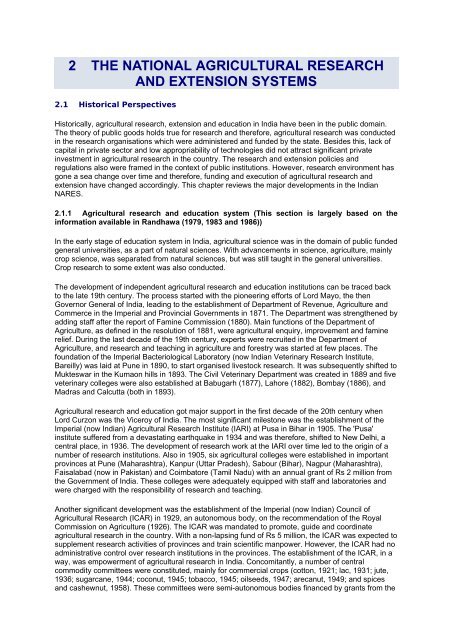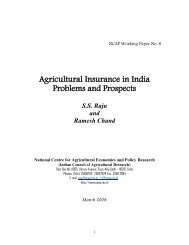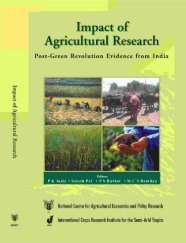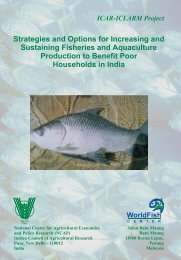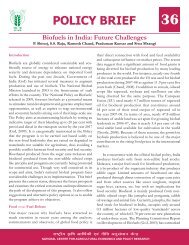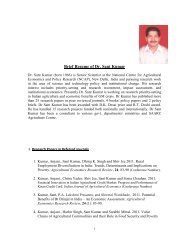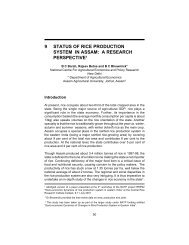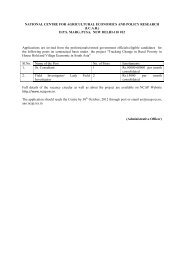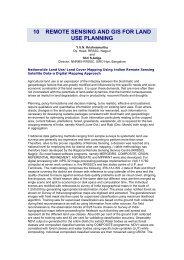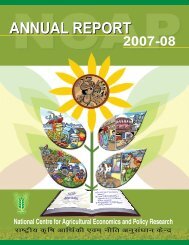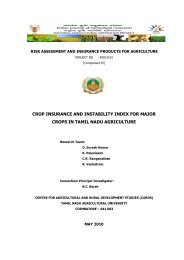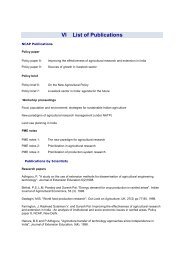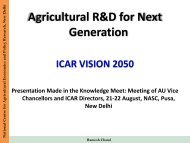2 the national agricultural research and extension systems - NCAP
2 the national agricultural research and extension systems - NCAP
2 the national agricultural research and extension systems - NCAP
Create successful ePaper yourself
Turn your PDF publications into a flip-book with our unique Google optimized e-Paper software.
2 THE NATIONAL AGRICULTURAL RESEARCH<br />
AND EXTENSION SYSTEMS<br />
2.1 Historical Perspectives<br />
Historically, <strong>agricultural</strong> <strong>research</strong>, <strong>extension</strong> <strong>and</strong> education in India have been in <strong>the</strong> public domain.<br />
The <strong>the</strong>ory of public goods holds true for <strong>research</strong> <strong>and</strong> <strong>the</strong>refore, <strong>agricultural</strong> <strong>research</strong> was conducted<br />
in <strong>the</strong> <strong>research</strong> organisations which were administered <strong>and</strong> funded by <strong>the</strong> state. Besides this, lack of<br />
capital in private sector <strong>and</strong> low appropriability of technologies did not attract significant private<br />
investment in <strong>agricultural</strong> <strong>research</strong> in <strong>the</strong> country. The <strong>research</strong> <strong>and</strong> <strong>extension</strong> policies <strong>and</strong><br />
regulations also were framed in <strong>the</strong> context of public institutions. However, <strong>research</strong> environment has<br />
gone a sea change over time <strong>and</strong> <strong>the</strong>refore, funding <strong>and</strong> execution of <strong>agricultural</strong> <strong>research</strong> <strong>and</strong><br />
<strong>extension</strong> have changed accordingly. This chapter reviews <strong>the</strong> major developments in <strong>the</strong> Indian<br />
NARES.<br />
2.1.1 Agricultural <strong>research</strong> <strong>and</strong> education system (This section is largely based on <strong>the</strong><br />
information available in R<strong>and</strong>hawa (1979, 1983 <strong>and</strong> 1986))<br />
In <strong>the</strong> early stage of education system in India, <strong>agricultural</strong> science was in <strong>the</strong> domain of public funded<br />
general universities, as a part of natural sciences. With advancements in science, agriculture, mainly<br />
crop science, was separated from natural sciences, but was still taught in <strong>the</strong> general universities.<br />
Crop <strong>research</strong> to some extent was also conducted.<br />
The development of independent <strong>agricultural</strong> <strong>research</strong> <strong>and</strong> education institutions can be traced back<br />
to <strong>the</strong> late 19th century. The process started with <strong>the</strong> pioneering efforts of Lord Mayo, <strong>the</strong> <strong>the</strong>n<br />
Governor General of India, leading to <strong>the</strong> establishment of Department of Revenue, Agriculture <strong>and</strong><br />
Commerce in <strong>the</strong> Imperial <strong>and</strong> Provincial Governments in 1871. The Department was streng<strong>the</strong>ned by<br />
adding staff after <strong>the</strong> report of Famine Commission (1880). Main functions of <strong>the</strong> Department of<br />
Agriculture, as defined in <strong>the</strong> resolution of 1881, were <strong>agricultural</strong> enquiry, improvement <strong>and</strong> famine<br />
relief. During <strong>the</strong> last decade of <strong>the</strong> 19th century, experts were recruited in <strong>the</strong> Department of<br />
Agriculture, <strong>and</strong> <strong>research</strong> <strong>and</strong> teaching in agriculture <strong>and</strong> forestry was started at few places. The<br />
foundation of <strong>the</strong> Imperial Bacteriological Laboratory (now Indian Veterinary Research Institute,<br />
Bareilly) was laid at Pune in 1890, to start organised livestock <strong>research</strong>. It was subsequently shifted to<br />
Mukteswar in <strong>the</strong> Kumaon hills in 1893. The Civil Veterinary Department was created in 1889 <strong>and</strong> five<br />
veterinary colleges were also established at Babugarh (1877), Lahore (1882), Bombay (1886), <strong>and</strong><br />
Madras <strong>and</strong> Calcutta (both in 1893).<br />
Agricultural <strong>research</strong> <strong>and</strong> education got major support in <strong>the</strong> first decade of <strong>the</strong> 20th century when<br />
Lord Curzon was <strong>the</strong> Viceroy of India. The most significant milestone was <strong>the</strong> establishment of <strong>the</strong><br />
Imperial (now Indian) Agricultural Research Institute (IARI) at Pusa in Bihar in 1905. The 'Pusa'<br />
institute suffered from a devastating earthquake in 1934 <strong>and</strong> was <strong>the</strong>refore, shifted to New Delhi, a<br />
central place, in 1936. The development of <strong>research</strong> work at <strong>the</strong> IARI over time led to <strong>the</strong> origin of a<br />
number of <strong>research</strong> institutions. Also in 1905, six <strong>agricultural</strong> colleges were established in important<br />
provinces at Pune (Maharashtra), Kanpur (Uttar Pradesh), Sabour (Bihar), Nagpur (Maharashtra),<br />
Faisalabad (now in Pakistan) <strong>and</strong> Coimbatore (Tamil Nadu) with an annual grant of Rs 2 million from<br />
<strong>the</strong> Government of India. These colleges were adequately equipped with staff <strong>and</strong> laboratories <strong>and</strong><br />
were charged with <strong>the</strong> responsibility of <strong>research</strong> <strong>and</strong> teaching.<br />
Ano<strong>the</strong>r significant development was <strong>the</strong> establishment of <strong>the</strong> Imperial (now Indian) Council of<br />
Agricultural Research (ICAR) in 1929, an autonomous body, on <strong>the</strong> recommendation of <strong>the</strong> Royal<br />
Commission on Agriculture (1926). The ICAR was m<strong>and</strong>ated to promote, guide <strong>and</strong> coordinate<br />
<strong>agricultural</strong> <strong>research</strong> in <strong>the</strong> country. With a non-lapsing fund of Rs 5 million, <strong>the</strong> ICAR was expected to<br />
supplement <strong>research</strong> activities of provinces <strong>and</strong> train scientific manpower. However, <strong>the</strong> ICAR had no<br />
administrative control over <strong>research</strong> institutions in <strong>the</strong> provinces. The establishment of <strong>the</strong> ICAR, in a<br />
way, was empowerment of <strong>agricultural</strong> <strong>research</strong> in India. Concomitantly, a number of central<br />
commodity committees were constituted, mainly for commercial crops (cotton, 1921; lac, 1931; jute,<br />
1936; sugarcane, 1944; coconut, 1945; tobacco, 1945; oilseeds, 1947; arecanut, 1949; <strong>and</strong> spices<br />
<strong>and</strong> cashewnut, 1958). These committees were semi-autonomous bodies financed by grants from <strong>the</strong>
Government of India <strong>and</strong>/or by income from cesses <strong>and</strong> were expected to promote overall commodity<br />
development, including <strong>research</strong>. In fact, many committees established <strong>research</strong> stations. These<br />
committees had representation of various stakeholders like producers, trade <strong>and</strong> industry, <strong>agricultural</strong><br />
department, etc., <strong>and</strong> Vice-President of <strong>the</strong> ICAR was ex-officio President of <strong>the</strong> committee. The<br />
funding of <strong>the</strong>se committees from cesses was <strong>the</strong> first attempt to link <strong>research</strong> funding with <strong>the</strong><br />
beneficiaries.<br />
The commodity approach to <strong>research</strong> lacked coordination between commodities <strong>and</strong> neglected<br />
<strong>research</strong> areas applicable across commodities like soil management. The need was, <strong>the</strong>refore,<br />
recognised to initiate <strong>research</strong> on cross-commodity basis. Also, <strong>the</strong> idea of regionalisation <strong>research</strong><br />
was getting momentum. These forces led to <strong>the</strong> establishment of Composite Regional Stations for<br />
<strong>research</strong> on cotton, oilseeds millets in 17 regions in 1956. These stations were under <strong>the</strong><br />
administrative control of <strong>the</strong> ICAR <strong>and</strong> <strong>research</strong> progress was monitored by <strong>the</strong> regional coordination<br />
committees. The <strong>research</strong> expenditure was shared by Indian Central Cotton Committee, <strong>the</strong> Indian<br />
Central Oilseeds Committee <strong>and</strong> <strong>the</strong> ICAR.<br />
Although <strong>the</strong> ICAR was established as a coordinating body, effective <strong>research</strong> coordination was<br />
missing because <strong>the</strong> ICAR did not have administrative control over many of <strong>the</strong> central or any of <strong>the</strong><br />
provincial <strong>research</strong> stations. In order to provide effective coordination to commodity <strong>research</strong>, <strong>the</strong><br />
concept of coordinated <strong>research</strong> project for improvement was introduced. In 1957, <strong>the</strong> first All India<br />
Coordinated Project on maize was started with <strong>the</strong> technical support from Rockfeller Foundation. The<br />
project was multidisciplinary in nature pooled staff working in different regions. This was <strong>the</strong> beginning<br />
<strong>research</strong> planning on <strong>the</strong> basis of agro-climatic zones, cutting ac political boundaries. The project was<br />
extremely successful <strong>and</strong> paved way for establishment of a series of all India coordinated <strong>research</strong><br />
projects.<br />
On <strong>the</strong> recommendation of <strong>the</strong> Agricultural Research Review T (1964), <strong>the</strong> ICAR was reorganised in<br />
1965 for coordinating, directing promoting <strong>agricultural</strong> <strong>research</strong> in <strong>the</strong> country. All <strong>the</strong> commodity<br />
committees were abolished <strong>and</strong> <strong>research</strong> institutes under <strong>the</strong>se committees <strong>and</strong> Central Department<br />
of Agriculture <strong>and</strong> Food gradually transferred to <strong>the</strong> ICAR. This led to centralisation of funding<br />
execution <strong>and</strong> management of <strong>agricultural</strong> <strong>research</strong> with greater autonomy <strong>and</strong> empowerment to <strong>the</strong><br />
ICAR. A Department of Agricultural Research <strong>and</strong> Education (DARE) was created in 1973 in <strong>the</strong><br />
central Ministry Agriculture to establish direct linkages of <strong>the</strong> ICAR with central <strong>and</strong> state<br />
governments, <strong>and</strong> inter<strong>national</strong> organisations. The Director General of ICAR, a scientist, was<br />
concurrently designated as Secretary to <strong>the</strong> DARE For centre-state coordination, eight regional<br />
committees were formed. Several new <strong>research</strong> institutions under <strong>the</strong> ICAR came into existence<br />
However, major expansion under <strong>the</strong> ICAR took place on <strong>the</strong> line commodity <strong>research</strong>. Funds for<br />
<strong>the</strong>se <strong>research</strong> institutes were channelled through <strong>the</strong> ICAR from <strong>the</strong> central government. Research<br />
stations under <strong>the</strong> administrative control of <strong>the</strong> state governments continued to be funded by state<br />
governments.<br />
Although a number of <strong>agricultural</strong> <strong>and</strong> veterinary colleges were functioning under <strong>the</strong> Department of<br />
Agriculture in <strong>the</strong> states, <strong>agricultural</strong> education maintained a low profile. These colleges were crippled<br />
with administrative <strong>and</strong> financial constraints. There was virtually no coordination between <strong>agricultural</strong><br />
<strong>and</strong> veterinary colleges. The University Education Commission (1949) felt <strong>the</strong> need for establishing<br />
rural (<strong>agricultural</strong>) universities in <strong>the</strong> states. Subsequently, <strong>the</strong> two Joint Indo-American Teams (1955<br />
<strong>and</strong> 1960) endorsed <strong>the</strong> establishment of state <strong>agricultural</strong> universities (SAUs). The SAUs were set up<br />
on l<strong>and</strong>-grant pattern of <strong>the</strong> American universities. The first one was started in 1960 at Pantnagar in<br />
Uttar Pradesh. The SAUs were given autonomous status <strong>and</strong> direct funding from <strong>the</strong> state<br />
governments. These universities imparted education on all aspects of agriculture on <strong>the</strong> same<br />
residential campus <strong>and</strong> integrated teaching with <strong>research</strong> <strong>and</strong> <strong>extension</strong>. The US Agency for<br />
Inter<strong>national</strong> Development (USAID) <strong>and</strong> <strong>the</strong> American l<strong>and</strong>-grant universities helped development of<br />
SAUs in India. Subsequently, implementation of <strong>the</strong> recommendations of <strong>the</strong> Education Commission<br />
(1964-66) <strong>and</strong> Review Committee on Agricultural Universities (1977/78) streamlined <strong>the</strong>ir functioning<br />
<strong>and</strong> all matters related to <strong>agricultural</strong> <strong>research</strong> in <strong>the</strong> states were transferred to <strong>the</strong> universities.<br />
The regional <strong>research</strong> capacity in <strong>the</strong> states was fur<strong>the</strong>r streng<strong>the</strong>ned by establishing <strong>the</strong> regional<br />
<strong>agricultural</strong> <strong>research</strong> stations under <strong>the</strong> National Agricultural Research Project (NATP) in 1979 with<br />
assistance from <strong>the</strong> World Bank. These <strong>research</strong> stations, in different agro-climatic zones of <strong>the</strong><br />
states, were under <strong>the</strong> administrative control of SAUs. Addressing zonal <strong>research</strong> needs <strong>and</strong> fostering<br />
linkages between <strong>research</strong>, <strong>extension</strong> <strong>and</strong> farmers were <strong>the</strong> main responsibilities of <strong>the</strong>se <strong>research</strong><br />
stations (Ghosh, 1991).
Meanwhile, <strong>the</strong>re has been tremendous growth in non-<strong>agricultural</strong> universities <strong>and</strong> o<strong>the</strong>r scientific<br />
organisations, notably, Council of Scientific <strong>and</strong> Industrial Research (CSIR), Department of<br />
Biotechnology (DBT), Defence Research <strong>and</strong> Development Organisation (DRDO) <strong>and</strong> Department of<br />
Science <strong>and</strong> Technology (DST). These organisations also continued to streng<strong>the</strong>n, directly or<br />
indirectly, <strong>agricultural</strong> <strong>research</strong> <strong>and</strong> education.<br />
The participation of industries both in public <strong>and</strong> private sectors in <strong>agricultural</strong> <strong>research</strong> was absent<br />
until 1950s. With <strong>the</strong> adoption of new seed-fertilizer technology in <strong>the</strong> mid-sixties, <strong>the</strong>re was<br />
phenomenal growth in <strong>the</strong> industrial sector for <strong>the</strong> production of inputs. However, <strong>research</strong> activities in<br />
<strong>the</strong>se industries were at <strong>the</strong> margin. The entry of private sector in seed <strong>research</strong> started in <strong>the</strong> 1970s<br />
with <strong>the</strong> popularisation hybrids. The passage of new policy on seed development in ' streamed seed<br />
<strong>research</strong> in <strong>the</strong> private sector, allowing participation trans<strong>national</strong> seed companies.<br />
2.1.2 Agricultural <strong>extension</strong> system<br />
The <strong>national</strong> <strong>agricultural</strong> <strong>extension</strong> system also evolved with establishment of <strong>the</strong> Department of<br />
Agriculture in <strong>the</strong> Imperial provincial governments. Efforts to streng<strong>the</strong>n this Department continued up<br />
to <strong>the</strong> time of Independence. Agricultural <strong>extension</strong> was one of activities of <strong>the</strong> Department <strong>and</strong> no<br />
special attention was paid accelerate transfer of technology efforts. However, some isolated attempts<br />
were made to start special rural development programmes, including improvement of agriculture<br />
(Prasad, 1989). Soon it was realised sporadic <strong>and</strong> adhoc programmes might not be effective <strong>and</strong> that<br />
<strong>the</strong>re was a need for sustained rural (including <strong>agricultural</strong>) development programmes. A nationwide,<br />
multi-purpose <strong>extension</strong> network backed with professionals became indispensable. Consequently, 55<br />
Comma Development Projects were started in 1952. Each project covered villages with a village level<br />
worker for a group of 10 villages. For e project, <strong>extension</strong> officers-technical persons in agriculture,<br />
animal husb<strong>and</strong>ry, cooperation, village industries <strong>and</strong> rural engineering-w provided. The programme<br />
was based on <strong>the</strong> philosophy of integrated rural development. In 1953, <strong>the</strong> National Extension Service<br />
Program identical to <strong>the</strong> community development programme but with less resource intensity, was<br />
launched with a view to cover <strong>the</strong> entire country 1960/61. The programme aimed to accelerate <strong>the</strong><br />
pace of rural development, including increased employment <strong>and</strong> production by application of scientific<br />
methods in agriculture. The programme greatly emphasised <strong>the</strong> principle of development through selfhelp<br />
<strong>and</strong> peoples participation. The central government largely bore <strong>the</strong> cost of programme.<br />
Front-line <strong>extension</strong> work also was initiated as <strong>agricultural</strong> <strong>research</strong> system grew in <strong>the</strong> ICAR <strong>and</strong><br />
SAUs. A department or directorate <strong>extension</strong> was established in <strong>the</strong> ICAR institutes <strong>and</strong> SAUs. The<br />
basic objective of <strong>the</strong>se departments was to conduct <strong>extension</strong> <strong>research</strong> demonstrate latest<br />
technologies, provide feedback to scientists, a provide training support to State Department of<br />
Agriculture. Besides, <strong>the</strong> ICAR started three major front-line <strong>extension</strong> projects, viz. National<br />
Demonstration Project (1965), Operational Research Project (1972) <strong>and</strong> Lab-to-L<strong>and</strong> Project (1979).<br />
Ano<strong>the</strong>r significant development in front-line <strong>extension</strong> was <strong>the</strong> establishment of Krishi Vigyan<br />
Kendras (KVKs) <strong>and</strong> Trainers' Training Centres (TTCs) in 1974. These KVKs <strong>and</strong> TTCs were aimed<br />
to improve technical literacy of farmers including rural women on <strong>the</strong> principle of 'teaching by doing<br />
<strong>and</strong> learning by doing'. These KVKs are currently managed by <strong>the</strong> ICAR institutes, SAUs <strong>and</strong><br />
nongovernmental organisations (NGOs) with financial support from <strong>the</strong> ICAR.<br />
The central government also launched several schemes to achieve self-sufficiency in food production.<br />
The important programmes were: Intensive Agricultural District Programme (1961) <strong>and</strong> Intensive<br />
Agricultural Areas Programme (1964). These programmes concentrated on <strong>the</strong> transfer of 'package of<br />
practices' <strong>and</strong> supply of critical inputs to farmers. In o<strong>the</strong>r words, <strong>extension</strong> strategy combined<br />
technical information with <strong>the</strong> supply of inputs. However, this strategy was discontinued with <strong>the</strong><br />
reorganisation of <strong>the</strong> <strong>extension</strong> system under <strong>the</strong> Training <strong>and</strong> Visit (T&V) System in 1974-75. The<br />
T&V system emphasised single-purpose professional <strong>extension</strong> workers, regular training of <strong>extension</strong><br />
personnel <strong>and</strong> transfer of technology through personal contact with farmers. This concept was fur<strong>the</strong>r<br />
streng<strong>the</strong>ned through establishing <strong>research</strong>-<strong>extension</strong>-farmer linkages under <strong>the</strong> National Agricultural<br />
Extension Project (NAEP) in 1979.<br />
Ano<strong>the</strong>r significant component of <strong>the</strong> <strong>extension</strong> system is <strong>the</strong> input industry, both in <strong>the</strong> public <strong>and</strong><br />
private sectors. As noted earlier <strong>the</strong> industrial sector entered in a big way in <strong>the</strong> dissemination of<br />
chemical <strong>and</strong> mechanical technologies in <strong>the</strong> 1960s. The late 1980s marked real beginning of private<br />
sector in seed business. Input industry promotes <strong>the</strong> use of modern inputs through mass media <strong>and</strong>
linking information with <strong>the</strong> supply of inputs. Several NGOs also got involved in agriculture <strong>and</strong> rural<br />
development activities during <strong>the</strong> period.<br />
2.2 Contemporary Institutional Structure of <strong>the</strong> NARES<br />
2.2.1 Agricultural <strong>research</strong> <strong>and</strong> education system<br />
The <strong>national</strong> <strong>agricultural</strong> <strong>research</strong> <strong>and</strong> education system (NARS), as evident from <strong>the</strong> historical<br />
developments reviewed above, is dominated by <strong>the</strong> public sector. Although agriculture is a state<br />
subject in <strong>the</strong> constitution of India, major components of <strong>the</strong> <strong>research</strong> system were initiated <strong>and</strong><br />
funded by <strong>the</strong> Union Government. The NARS has three main institutional set up with different<br />
m<strong>and</strong>ates. These are: ICAR institutes to cater to upstream <strong>research</strong> needs, SAUs engaged in<br />
teaching <strong>and</strong> <strong>research</strong> for respective states, <strong>and</strong> ZARSs to undertake zonal-specific <strong>research</strong>. A<br />
structural diagram depicting <strong>the</strong>se institutions <strong>and</strong> <strong>the</strong>ir linkages with o<strong>the</strong>r actors like public <strong>research</strong><br />
organisations, inter<strong>national</strong> <strong>research</strong> centres <strong>and</strong> private sector is shown in Figure 2.1. The direction<br />
of <strong>research</strong> linkages is shown with arrows. The ICAR is <strong>the</strong> apex body at <strong>the</strong> centre to promote,<br />
undertake <strong>and</strong> coordinate <strong>research</strong> in all fields of agriculture in <strong>the</strong> country. The ICAR is linked with<br />
<strong>the</strong> Union Ministry of Agriculture through <strong>the</strong> DARE. The Council also coordinates directly with state<br />
governments <strong>and</strong> inter<strong>national</strong> organisations through <strong>the</strong> DARE. The Governing Body consisting of<br />
eminent <strong>agricultural</strong> scientists, academicians, legislators <strong>and</strong> farmers' representatives as its members,<br />
is <strong>the</strong> chief executive <strong>and</strong> policy making authority <strong>and</strong> <strong>the</strong> General Body is <strong>the</strong> supreme body of <strong>the</strong><br />
ICAR.<br />
By <strong>the</strong> end of <strong>the</strong> Eighth Plan, <strong>the</strong> ICAR had established a network of 45 <strong>research</strong> institutes, 10<br />
project directorates (PDs), 30 <strong>national</strong> <strong>research</strong> centres (NRCs), 4 <strong>national</strong> bureaux (NB) <strong>and</strong> 86 all<br />
India coordinated <strong>research</strong> projects (AlCRPs), etc. Four <strong>research</strong> institutes have <strong>the</strong> status of <strong>national</strong><br />
institute <strong>and</strong> <strong>the</strong> rest are named as central institutes. The major <strong>research</strong> activities of <strong>the</strong>se ICAR<br />
institutions are given in Table 2.1.<br />
A large number of <strong>the</strong> ICAR <strong>research</strong> institutes conduct basic/strategic, <strong>and</strong> applied <strong>research</strong> in<br />
discipline-based divisional set-up (Table 2.1). IARI, NDRI, IVRI, CIFE with <strong>the</strong> status of 'deemed<br />
university' also undertake post-graduate teaching in agriculture. The AlCRPs have <strong>the</strong>ir <strong>research</strong><br />
centres at <strong>the</strong> SAUs <strong>and</strong> are engaged in applied <strong>research</strong>. Some AlCRPs are elevated to <strong>the</strong> status of<br />
project directorate to provide backstopping <strong>research</strong>. The NRCs conduct <strong>research</strong> on specific<br />
problems in mission mode, non-divisional set-up. Although ICAR institutes are m<strong>and</strong>ated to do basic<br />
<strong>and</strong> strategic <strong>research</strong>, a good deal of applied <strong>research</strong> is also conducted due to low <strong>research</strong><br />
intensity in <strong>the</strong> SAUs. All <strong>the</strong> ICAR <strong>research</strong> institutions are managed by <strong>the</strong> management committee<br />
<strong>and</strong> <strong>research</strong> advisory committee. The management committee has wide representation, while<br />
<strong>research</strong> committee is a body of <strong>research</strong> professionals. Most of <strong>the</strong> ICAR institutions are organised<br />
on commodity pattern <strong>and</strong> very few are resource or discipline based.<br />
The SAUs are autonomous institutions for meeting educational <strong>and</strong> <strong>research</strong> needs of <strong>the</strong> states <strong>and</strong><br />
<strong>the</strong>se are managed by <strong>the</strong> board of management <strong>and</strong> academic council. All <strong>the</strong> states have at least<br />
one SAU. The ZARSs under <strong>the</strong> SAUs are m<strong>and</strong>ated to cater to <strong>research</strong> needs of <strong>the</strong> zones. The<br />
SAUs are largely funded by state governments, but <strong>the</strong>y also get regular grant from <strong>the</strong> ICAR. One<br />
Central Agricultural University with funding from <strong>the</strong> Union Government is also established for<br />
nor<strong>the</strong>astern states.
Figure 2.1<br />
Institutional structure of <strong>the</strong> Indian <strong>agricultural</strong> <strong>research</strong> <strong>and</strong> educational system
Table 2.1<br />
Major activities of <strong>the</strong> ICAR <strong>and</strong> SAUs <strong>research</strong> system<br />
Institution Number Main activities Budget<br />
(1994/95)* (Rs,<br />
million)<br />
ICAR<br />
National <strong>research</strong><br />
institute<br />
Central <strong>research</strong><br />
institutes<br />
4 Basic <strong>and</strong> strategic <strong>research</strong> of <strong>national</strong><br />
importance, education, man-power training<br />
41 Commodity/resource specific basic <strong>and</strong> strategic<br />
<strong>research</strong> with divisional set-up, education<br />
827<br />
1526<br />
National bureaux 4 Conservation <strong>and</strong> exchange of germplasm, soil<br />
survey<br />
Project directorates 10 To fill critical <strong>research</strong> gap in All India<br />
Coordinated Research Projects, <strong>research</strong><br />
coordination<br />
113<br />
319<br />
National <strong>research</strong><br />
centres<br />
All India<br />
coordinated<br />
<strong>research</strong> projects<br />
Agricultural<br />
universities<br />
30 Commodity/resource/discipline based strategic<br />
<strong>research</strong> in mission mode<br />
86 Coordination of commodity/resource specific<br />
<strong>research</strong> in different zones of <strong>the</strong> country<br />
228<br />
861<br />
5327<br />
Central<br />
university<br />
agric.<br />
1 Applied <strong>research</strong> <strong>and</strong> education for north<br />
eastern states<br />
SAUs 28 Applied <strong>research</strong> for <strong>the</strong> state <strong>and</strong> education<br />
Zonal<br />
stations**<br />
<strong>research</strong><br />
120 Adaptive <strong>research</strong> for <strong>the</strong> zone<br />
Source: ICAR (1996/97),<br />
** Ghosh (1991);<br />
* ICAR (1995/96)<br />
Figure 2.2 shows geographical spread of ICAR institutions <strong>and</strong> SAUs in <strong>the</strong> country. All important<br />
states have at least one SAU <strong>and</strong> most of <strong>the</strong> SAUs are multi-campus. Some states have established<br />
new SAUs by elevating old campus to university. Although efforts were made to establish ICAR<br />
institutions in <strong>the</strong> major producing state of <strong>the</strong> m<strong>and</strong>ated commodity, <strong>the</strong>re appear to be some<br />
influence of political-economic factors. For example, a large number of institutions were established in<br />
<strong>the</strong> nor<strong>the</strong>rn <strong>and</strong> sou<strong>the</strong>rn states- <strong>the</strong> states having larger representation in <strong>the</strong> Union Ministry of<br />
Agriculture, while western <strong>and</strong> north-eastern states were given low priority. Only recently, one<br />
<strong>agricultural</strong> university with <strong>the</strong> central assistance has been established.
A large number of non-<strong>agricultural</strong> universities, government organisations <strong>and</strong> public sector<br />
undertakings are also involved directly or indirectly in <strong>agricultural</strong> <strong>research</strong>. Some universities like<br />
Banaras Hindu University, have independent faculty for <strong>agricultural</strong> <strong>research</strong> <strong>and</strong> education, while<br />
government departments or scientific organisations like DST, DBT, CSIR, DRDO, etc. conduct or<br />
support <strong>agricultural</strong> <strong>research</strong> directly or indirectly. The public sector industrial units are also involved<br />
in <strong>agricultural</strong> <strong>research</strong>, mainly on inputs, to some extent.<br />
Private sector undertakes <strong>research</strong> for <strong>the</strong> development of embodied technologies, viz. chemical,<br />
mechanical <strong>and</strong> biological (only hybrids). However, private sector <strong>research</strong> so far is adaptive in nature<br />
<strong>and</strong> is expected to intensify in <strong>the</strong> years to come with <strong>the</strong> adoption of favourable industrial <strong>and</strong><br />
regulatory policies. Several private foundations, both <strong>national</strong> <strong>and</strong> inter<strong>national</strong>, also conduct <strong>and</strong>/or<br />
invest in <strong>agricultural</strong> <strong>research</strong> in <strong>the</strong> country.<br />
Research linkages <strong>and</strong> coordination<br />
Considering <strong>the</strong> size <strong>and</strong> multi-institutional set-up of <strong>the</strong> NARS, developing <strong>research</strong> linkages <strong>and</strong><br />
coordination is a formidable challenge. The task is fur<strong>the</strong>r complicated by <strong>the</strong> fact that <strong>the</strong><br />
responsibility of <strong>agricultural</strong> <strong>research</strong> <strong>and</strong> development lies with state governments. The ICAR as an<br />
apex body, coordinates <strong>research</strong> <strong>and</strong> promotes inter-institutional <strong>research</strong> linkages. Since <strong>the</strong> ICAR<br />
supports SAUs through regular grants, it has direct participation in <strong>the</strong> management of <strong>the</strong> SAUs.<br />
Besides, regional committees were formed in 1975 to assess <strong>the</strong> status of <strong>research</strong>, <strong>extension</strong> <strong>and</strong><br />
education in <strong>the</strong> ICAR institutes <strong>and</strong> SAUs in <strong>the</strong> eight regions of <strong>the</strong> country. These committees also<br />
make recommendations to undertake <strong>research</strong> on immediate problems of <strong>the</strong> region. Officials from<br />
<strong>the</strong> ICAR, ICAR institutes, SAUs, state line department, NGOs, members of parliament <strong>and</strong> farmers<br />
representatives are members of <strong>the</strong>se committees. The geographical coverage of <strong>the</strong>se regions is<br />
given in Appendix I.<br />
Ano<strong>the</strong>r informal but effective link between various <strong>research</strong> institutions is <strong>the</strong> cross-nomination of<br />
members in various committees <strong>and</strong> scientific panels. As noted above, <strong>the</strong>se committees <strong>and</strong>
scientific panels have major say in planning <strong>and</strong> management of <strong>research</strong>. Efforts are made to ensure<br />
effective use of <strong>research</strong> resources <strong>and</strong> to avoid duplication of <strong>research</strong> efforts.<br />
Research collaboration with <strong>the</strong> CGIAR system, NARSs <strong>and</strong> <strong>research</strong> foundations overseas, etc. is<br />
operationalised by <strong>the</strong> ICAR through <strong>the</strong> DARE. However, SAUs can also directly collaborate with<br />
<strong>the</strong>se inter<strong>national</strong> organisations. Linkages with <strong>the</strong> <strong>national</strong> private <strong>research</strong> organisations are direct.<br />
Public <strong>research</strong> institutions extend support such as supply of germplasm <strong>and</strong> training facilities to <strong>the</strong><br />
private sector. Also, private <strong>research</strong> companies can collaborate directly with multi<strong>national</strong> companies<br />
or private <strong>research</strong> foundations abroad under <strong>the</strong> existing regulations which recently have been<br />
liberalised to a great extent (for detailed discussion, see Singh et al., 1995).<br />
2.2.2 Agricultural <strong>extension</strong> system<br />
Broadly, <strong>the</strong>re are four major components of <strong>the</strong> Indian <strong>extension</strong> or transfer of technology system: (i)<br />
<strong>agricultural</strong> <strong>extension</strong> service with <strong>the</strong> state governments, (ii) <strong>extension</strong> education system of ICAR <strong>and</strong><br />
SAD system, (iii) <strong>extension</strong> programme of input industries in public <strong>and</strong> private sectors <strong>and</strong> NGOs,<br />
<strong>and</strong> (iv), special rural development programmes of <strong>the</strong> central <strong>and</strong> state governments. However, main<br />
responsibility of transfer of technology rests with <strong>the</strong> state governments as agriculture is a state<br />
subject. The central government also implements several schemes having transfer of technology<br />
component, through <strong>the</strong> state governments.<br />
Institutional structure of <strong>the</strong> Indian <strong>extension</strong> system is shown in Figure 2.3. The main <strong>extension</strong><br />
system comprises <strong>the</strong> Directorate of Extension in <strong>the</strong> Union Ministry of Agriculture at <strong>the</strong> centre <strong>and</strong><br />
T&V system under <strong>the</strong> state Department of Agriculture. In <strong>the</strong> T&V system, professional <strong>extension</strong><br />
workers work with contact farmers for <strong>the</strong> transfer of information <strong>and</strong> skill. Training support to <strong>the</strong> T&V<br />
system is provided by <strong>the</strong> ICAR/SAU system (for details of T&V system, see Misra, 1990). The<br />
Directorate of Extension plans <strong>extension</strong> activities at <strong>national</strong> level <strong>and</strong> disseminates information<br />
through mass media <strong>and</strong> publication of literature. For training of <strong>extension</strong> staff, <strong>the</strong>re is a three-tier<br />
training system. At <strong>the</strong> <strong>national</strong> level for training of senior <strong>and</strong> middle level staff, an autonomous<br />
institute, namely, National Institute of Agricultural Extension Management (MANAGE) was<br />
established. There are four regional <strong>extension</strong> training institutes <strong>and</strong> several state training institutes<br />
for training of <strong>extension</strong> workers. Several development programmes like integrated rural development<br />
programme, watershed development programme, operation flood, technology mission for crops, etc.<br />
sponsored by o<strong>the</strong>r government departments contain transfer of technology component. In 1994, <strong>the</strong><br />
scope of <strong>extension</strong> was widened under <strong>the</strong> broadbased <strong>agricultural</strong> <strong>extension</strong>' in farming system<br />
approach to include all l<strong>and</strong>based activities.
Figure 2.3<br />
Institutional structure of <strong>the</strong> Indian <strong>agricultural</strong> <strong>extension</strong> system<br />
The ICAR/SAU front-line <strong>extension</strong> system plays a catalytic <strong>and</strong> supportive role. It develops <strong>extension</strong><br />
methodology, refines <strong>and</strong> transfers front-line technologies, <strong>and</strong> provides feedback to scientists. This<br />
system has three approaches. First is <strong>the</strong> special transfer of technology programmes like National<br />
Demonstration (ND), Operation Research Project (ORP), <strong>and</strong> Lab-to-l<strong>and</strong> Programme (LLP). Most<br />
recent in <strong>the</strong> series is <strong>the</strong> Institute-Village Linkage Programme started in 1995/96 for technology<br />
assessment <strong>and</strong> refinement. The second approach comprises <strong>the</strong> transfer of technology <strong>and</strong> training<br />
by <strong>the</strong> KVKs <strong>and</strong> TTCs on <strong>the</strong> principle of 'learning by doing'. There are 261 KVKs functioning in <strong>the</strong><br />
country under <strong>the</strong> ICAR institutes, SAUs <strong>and</strong> NGOs. Front-line <strong>extension</strong> programmes (ND, ORP,<br />
LLP) are presently merged with <strong>the</strong> KVKs. Eight TTCs provide training to <strong>the</strong> KVK staff. In <strong>the</strong> third<br />
approach, ICAR/SAU system provide training to <strong>the</strong> master trainers (subject matter specialists)<br />
working in <strong>the</strong> state line department through monthly workshops.<br />
Private input companies are involved only in <strong>the</strong> transfer of chemical (fertilizers, pesticides),<br />
mechanical <strong>and</strong> biological (hybrid seeds) technologies developed/produced by <strong>the</strong>m. Public sector<br />
companies <strong>and</strong> seed corporations also undertake transfer of technology activities related to <strong>the</strong> sale<br />
of <strong>the</strong>ir products i.e., farm inputs. Commodity groups/boards also promote commodity specific
<strong>extension</strong> activities. Many NGOs also undertake <strong>extension</strong> activities as part of <strong>the</strong>ir development<br />
programmes. Some NGOs are also managing ICAR-supported KVKs.<br />
Research-<strong>extension</strong> linkages<br />
Efforts have been made to institutionalise <strong>research</strong>-<strong>extension</strong> linkages at <strong>national</strong>, regional, state <strong>and</strong><br />
zonal levels. At <strong>the</strong> <strong>national</strong> level, under <strong>the</strong> ICAR-DAC interface joint meetings of <strong>the</strong> senior officers<br />
from <strong>the</strong> ICAR <strong>and</strong> Department of Agriculture <strong>and</strong> Cooperation (DAC) are organised twice a year to<br />
discuss critical <strong>research</strong> <strong>and</strong> development issues. At <strong>the</strong> regional level, eight regional committees<br />
were constituted to review <strong>research</strong> <strong>and</strong> development status in <strong>the</strong> ICAR institutes <strong>and</strong> SAUs located<br />
in <strong>the</strong> region. These committees represented by <strong>the</strong> senior <strong>research</strong> <strong>and</strong> <strong>extension</strong> officers, farmers<br />
representatives <strong>and</strong> NGOs meet once in two years. The Zonal Agricultural Research <strong>and</strong> Extension<br />
Advisory Committee meetings <strong>and</strong> seasonal workshops at <strong>the</strong> zonal level facilitate close interaction<br />
between <strong>research</strong>ers, <strong>extension</strong> workers <strong>and</strong> farmers. In <strong>the</strong> T&V system, <strong>research</strong>-<strong>extension</strong><br />
linkages are institutionalised through monthly/bimonthly workshops for <strong>the</strong> training of master trainers<br />
or subject matter specialists in state line department by <strong>the</strong> <strong>research</strong>ers.<br />
To sum up, it may be concluded that although <strong>the</strong> Indian NARES have grown in size <strong>and</strong> efforts, <strong>the</strong>y<br />
are still dominated by government funded <strong>and</strong> administered institutions. There have been some<br />
initiatives like provision of contract <strong>research</strong>, rationalisation of seed regulations <strong>and</strong> entry of trans<strong>national</strong>s,<br />
in <strong>the</strong> recent past to diversify <strong>the</strong> NARES by encouraging private sector <strong>and</strong> NGOs. These<br />
efforts should be streng<strong>the</strong>ned in future for efficient provision of <strong>research</strong> <strong>and</strong> <strong>extension</strong> services to<br />
farmers through diversified institutional arrangements.


